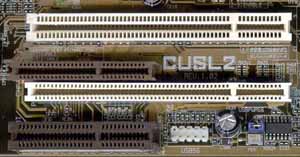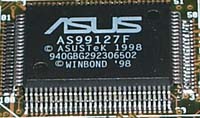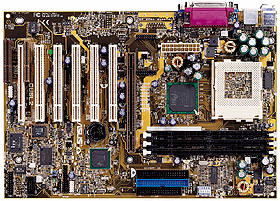
Original Link: https://www.anandtech.com/show/578
For whatever reason, some companies manage to garner a sort of "cult" following. It's usually a result of high-quality products time and time again. ASUS happens to be one of those companies in the motherboard industry. Interestingly, we learned from our recent trip to Taiwan that competing manufacturers seem to look up to ASUS as the benchmark to strive for. So obviously they're doing something right and we tend to agree based on our experience with ASUS boards dating back to the T2P4, one of the first motherboards to support the 83MHz FSB speed.
With Intel's recent introduction of the i815 and i815E chipsets, it seems that we finally have a decent replacement for the venerable i440BX. The ASUS version is known as the CUSL2 and we've been trying to get a hold of one ever since it was announced at Computex 2000. A board finally arrived in the lab and we've scrutinized every detail to find out if ASUS is able to garner a second AnandTech Editor's Choice Award in the 133 MHz arena.
|
Motherboard Specifications |
|
| CPU Interface |
Socket-370
|
| Chipset |
Intel i815E
|
| Form Factor |
ATX
|
| Bus Speeds |
66
/ 100 / 133 / 166 / 203 / 205 / 210 / 216
67 - 97 (in 1 MHz increments) 102 - 132 (in 1 MHz increments) 135 - 200 (in 1 MHz increments) |
| Voltages Supported |
Auto Detect
(increase by up to 0.30V in 0.05V increments) |
| Memory Slots |
3 168-pin DIMM Slots
|
| Expansion Slots |
1 AGP Pro 50 Slot
6 PCI Slots (6 Full Length) 2 CNR Slots (2 Shared) 0 ISA Slots |
| Onboard Sound |
Cirrus
Logic CrystalClearSoundFusion CS4299 AC'97
|
| BIOS |
Award Medallion BIOS 6.00
|
The Good
ASUS always seems to have some of the most innovative motherboards, and the CUSL2 is no exception, featuring by far one of the strangest looking innovations we've ever seen at AnandTech. It comes as a result of the 6/1/2/0 (PCI/AGP/CNR/ISA) expansion slot configuration. The key to making this configuration possible is the two PCI/CNR shared slots, but in order for ASUS to accomplish that, they had to come up with "new" PCI and CNR slots that are actually thinner than normal slots so that everything can physically fit on the PCB. Although the slots do look a bit odd, rest assured that they accept standard PCI and CNR cards.
But the question remains - why would you need two CNR slots? Well, it does add some flexibility to the CUSL2, allowing users to add first a modem riser and later a network riser or any combination of two devices, rather than being forced to buy the appropriate riser with everything they want all at once.

Thanks to the 82815 Graphics Memory Controller Hub (GMCH) if the i815E, we finally have official support for the 133 MHz FSB and PC133 SDRAM from Intel. Three DIMM slots cover memory expansion possibilities of the CUSL2. While the 82815 officially only supports 2 PC133 DIMM's, the CUSL2 had no problem running 3 DIMM's in PC133 mode. The 512MB total memory limit of the 82815 is still in effect, however. While many AnandTech readers probably won't make use of it, the 82815 also features integrated i752-based 3D graphics. Fortunately, it also offers an AGP 4X slot for higher performance systems or future expansion. In the case of the CUSL2, it's actually an AGP Pro 50 slot as we've seen from ASUS on many of their recent boards. Unlike the i810 chipset, the optional display cache is not included on the motherboard, but can be added via a Graphics Performance Accelerator (GPA) card that sits in the AGP slot, but it's still the same old display cache from the i810.
In line with the fact that the CUSL2 is a top of the line board is the inclusion of the 82801BA I/O Controller Hub 2 (ICH2), which is what differentiates the i815E from the regular i815 chipset. Compared to ICH1, ICH2 adds support for Ultra ATA/100, a second USB controller, and an integrated Intel 82559 network controller. Of course ICH2 also includes everything that ICH1 featured, such as support for 6 bus mastering PCI slots and AC'97 host-based audio. ICH2 is connected to the GMCH by Intel's 266 MB/s Accelerated Hub Architecture (AHA), just like the original ICH. The USB controller is also still USB 1.1 - we'll have to wait a bit longer before we see USB 2.0. The AC'97 audio is upgraded to support up to 6 channels of audio, although anyone serious about their sound will want to get a true hardware based PCI solution. Although our sample didn't include the AC'97 CODEC, ASUS uses the Cirrus Logic CrystalClearSoundFusion CS4299 to handle those duties.
As we showed in our Ultra ATA/66 vs. Ultra ATA/33 Comparison, Ultra ATA/66 is just beginning to show a performance improvement over Ultra ATA/33, so it will probably be a while before we see the benefits of Ultra ATA/100. ASUS didn't seem to think the 4 USB ports provided by ICH2's 2 USB controllers were enough, so they threw in an optional Alcor Micro AU9254 USB Hub that brings the total USB count up to 7. It's basically a single chip generic USB hub so there are no drivers to worry about and it should work under any OS that supports USB. Unlike many manufacturers, ASUS actually includes the necessary header to take advantage of additional USB ports. Unfortunately, the header ASUS includes only supports 3 additional ports, so two still remain unused. The integrated 82559 network controller supports 10MBps Home PNA 2.0 or 10/100 Ethernet depending on the CNR card that is plugged in.
With the CUSL2, ASUS also introduces another new innovation for their motherboards, known as the ASUS iPanel. It sits in an external 5.25" drive bay and provides access to the onboard audio ports, an infrared module, and front panel I/O ports, all while leaving room for an internal 3.5" device inside the iPanel so that 5.25" bay is not completely wasted. The exact specs of the iPanel have yet to be determined so they are subject to change. It will be an extra cost option not included with the motherboard.
Like all recent ASUS boards, the CUSL2 uses Award's Medallion BIOS 6.00, which looks a lot like the old Phoenix BIOS, most likely due to the merger between Phoenix and Award last year. While the Medallion BIOS looks and operates like a Phoenix BIOS, it offers all the tweaking options we've come to expect from the standard Award setup found on virtually all other boards out there. When it comes to BIOS support, ASUS is quite possibly the best manufacturer, with constant BIOS updates and betas available seemingly every week. In the past, they've continued that support with fixes and new features even after the board has been discontinued.
Within the BIOS, you'll find ASUS's JumperFree CPU Setup under the "Advanced" menu. For those of you that prefer a hardware CPU setup, DIP switches are available on the board, although not all the FSB speeds of JumperFree are available. The rendition of JumperFree on the CUSL2 is one of the most flexible CPU setup we've ever seen, at least in terms of available FSB speeds where it has more than any other board, including the previous champ ABIT BE6-2. ASUS allows independent selection of the FSB:SDRAM:PCI ratio and the actual FSB speed. Available options for the FSB:SDRAM:PCI ratio include 133:133:33, 133:100:33, 100:100:33, and 66:100:33. Each ratio includes its own set of FSB options, which are shown in the table below since it's a bit more complicated than most motherboards.
|
FSB:SDRAM:PCI Ratio |
Available FSB Speeds
|
|
133:133:33
|
133
/ 166
135 - 160 (in 1 MHz increments) |
|
133:100:33
|
133
/ 203 / 205
/ 210 / 216
135 - 200 (in 1 MHz increments) |
|
100:100:33
|
100
102 - 132 (in 1 MHz increments) |
|
66:100:33
|
66 - 97 MHz (in 1 MHz increments)
|
Interestingly enough, additional FSB speeds are opened up for 133 MHz CPU's when the memory clock is turned down to 3/4 of the FSB speed. Those FSB speeds reach up to a phenomenal 216 MHz, although it's unlikely that anyone will be able to use such high speeds, especially with all Intel CPU's multiplier locked. However, the flexibility of FSB speeds available in 1 MHz increments in most cases is very useful for tweaking the most out of your CPU, regardless of what type of CPU you're using. The independent selection of FSB:SDRAM:PCI ratio certainly comes in handy when you're exploring the limits of your CPU and RAM simultaneously.
In fact, ASUS even has a recommendation in the right hand panel of the BIOS that suggests using the 133:100:33 ratio with FSB speeds above 145 MHz since that will be pushing the limits of most PC133 SDRAM. If you try to overclock your CPU too far and the system fails to POST, the next time you try to boot up, the motherboard defaults to fail-safe settings. Next, the CPU configuration screen in the BIOS pops up letting you know that you need to choose new CPU settings. Nice to see that ASUS is looking out for all the overclockers out there ;)
Speaking of overclocking, ASUS hasn't forgotten some of the other little tricks that let us tweak our CPU's to the limit. That means we get core voltage tweaks in the BIOS, up to 0.30V over the default voltage in 0.05V increments. Along the same lines, ASUS was one of the first to offer I/O voltage adjustments on the CUSL2 continues that support via jumpers on the motherboard - options include 3.30V, 3.40V, and 3.60V with 3.40V the default. Direct control over SDRAM timing is included as well. Although not specifically labeled in the BIOS, the AGP:FSB ratio is automatically set based on the FSB:SDRAM:PCI ratio to keep things within spec at 66 / 100 / 133 FSB speeds and as close as possible when overclocking.
 To
help ensure stability, ASUS has included eleven 1500uF capacitors around the
Socket-370 interface. And it seems to have worked as the CUSL2 was rock solid
in both overclocked and non-overclocked situations, matching our experience
with most ASUS boards in the past. Hardware
monitoring is provided by a custom ASUS AS99127F ASIC that can monitor 3 temperatures,
3 fan speeds, and 6 voltages. In the case of the CUSL2, CPU temperature is read
from the on-die thermal diode found on all Socket-370 Intel CPU's. An external
thermistor header, designated for power supply temperature, but could really
be used for anything, is located between the third and fourth PCI slots.
To
help ensure stability, ASUS has included eleven 1500uF capacitors around the
Socket-370 interface. And it seems to have worked as the CUSL2 was rock solid
in both overclocked and non-overclocked situations, matching our experience
with most ASUS boards in the past. Hardware
monitoring is provided by a custom ASUS AS99127F ASIC that can monitor 3 temperatures,
3 fan speeds, and 6 voltages. In the case of the CUSL2, CPU temperature is read
from the on-die thermal diode found on all Socket-370 Intel CPU's. An external
thermistor header, designated for power supply temperature, but could really
be used for anything, is located between the third and fourth PCI slots.
ASUS manuals have always been some of the best in the industry and nothing has changed with the CUSL2, which ships with the usual high quality ASUS manual as well as a helpful CD that contains all of the necessary drivers and utilities to get your system up and running reliably. They even let you know exactly which slots share IRQ's with other slots or devices. Nothing but the best, which is what we've come to expect from a company like ASUS.
The Bad
There really isn't much to complain about with the CUSL2, but nothing is ever perfect.
Although ASUS includes the necessary header to take advantage of 3 additional USB ports, the CUSL2 actually features 5 additional USB ports for a total of 7. We'd also like to see ASUS include the ethernet port integrated on the motherboard, at least as an option, since it is included with the ICH2 that's already onboard.
One of the most frustrating "features" of ASUS boards is the lack of a CMOS reset jumper. You can clear the CMOS by contacting two solder points, labeled CLRTC, with a piece of metal. This method is not documented in the manual and we don't recommend it either. Instead, simply remove the battery from it's socket momentarily with the ATX power unplugged.
While it's not really a fault of the ASUS CUSL2, you'll be paying extra for the integrated graphics of the i815 even if you plan to use your own AGP graphics card.
USB Compatibility
-
Number of Front Universal Serial Bus Root Ports: 5
-
Number of Rear Universal Serial Bus Root Ports: 2
-
USB IRQ Enable/Disable in BIOS: Yes
-
USB Keyboard Support in BIOS: Yes
Recommended SDRAM
Recommended SDRAM: 1 x 128MB Corsair PC133 SDRAM; 1 x 128MB Mushkin PC133 SDRAM
SDRAM Tested: 1 x 128MB Corsair PC133 SDRAM; 1 x 128MB Mushkin PC133 SDRAM
Manufacturer:
Corsair
Purchase Website: http://www.corsairmicro.com
Manufacturer:
Mushkin
Purchase Website: http://www.mushkin.com
The Test
In recent times, choosing a motherboard cannot be completely determined by a Winstone score. Now, many boards come within one Winstone point of each other and therefore the need to benchmark boards against each other falls. Therefore you shouldn't base your decision entirely on the benchmarks you see here, but also on the technical features and advantages of this particular board, seeing as that will probably make the greatest difference in your overall experience.
Click Here to learn about AnandTech's Motherboard Testing Methodology.
|
Test Configuration |
|
| Processor(s): |
Intel
Pentium III 733 OEM
|
| RAM: | |
| Hard Drive(s): |
Western Digital 153BA
Ultra ATA/66 7200 RPM
|
| Bus Master Drivers: |
Intel Ultra ATA 6.00
|
| Video Card(s): |
NVIDIA
GeForce 256 SDR
|
| Video Drivers: |
NVIDIA
Detonator 5.22
|
| Operation System(s): |
Windows
98 SE
|
| Motherboard Revision: |
ASUS
CUSL2 Revision 1.02
|
|
Windows 98 Performance |
|||
|
SYSMark
2000
|
Content
Creation
Winstone 2000 |
Quake
3 Arena
640x480x16 |
|
| ASUS CUSL2 - Pentium III 733 (i815) |
163
|
31.6
|
126.4
|
| ASUS CUBX - Pentium III 733 (i440BX) |
164
|
31.3
|
130.5
|
| ASUS P3V4X - Pentium III 733 (VIA 133A) |
156
|
29.6
|
119.3
|
Final Words
 The
ASUS CUSL2 is the first i815 motherboard we've reviewed. So while it may seem
a bit premature to bestow an Editor's Choice Award, we know a great motherboard
when we see one. ASUS has thrown everything into the CUSL2 but the kitchen sink
- and we wouldn't be surprised if that popped up somewhere in here. ASUS has
raised the bar once again with the CUSL2 and other manufacturers should now
know what to shoot for. The CUSL2 is a a board that should satisfy anyone looking
for a top notch i815 solution.
The
ASUS CUSL2 is the first i815 motherboard we've reviewed. So while it may seem
a bit premature to bestow an Editor's Choice Award, we know a great motherboard
when we see one. ASUS has thrown everything into the CUSL2 but the kitchen sink
- and we wouldn't be surprised if that popped up somewhere in here. ASUS has
raised the bar once again with the CUSL2 and other manufacturers should now
know what to shoot for. The CUSL2 is a a board that should satisfy anyone looking
for a top notch i815 solution.
How it Rates
|
AnandTech Motherboard Rating |
|
|
Rating
(x/10)
|
|
|
Performance
|
7.5
|
|
Price
|
4.0
|
|
Stability
|
9.5
|
|
Quality
|
9.0
|
|
Features
|
9.5
|
|
Layout
|
6.5
|
|
Availability
|
7.0
|
|
Documentation & Software Bundle
|
7.5
|
| Overall Rating - not an average Click here to find out why |
9.0
|








